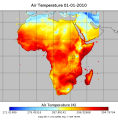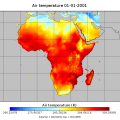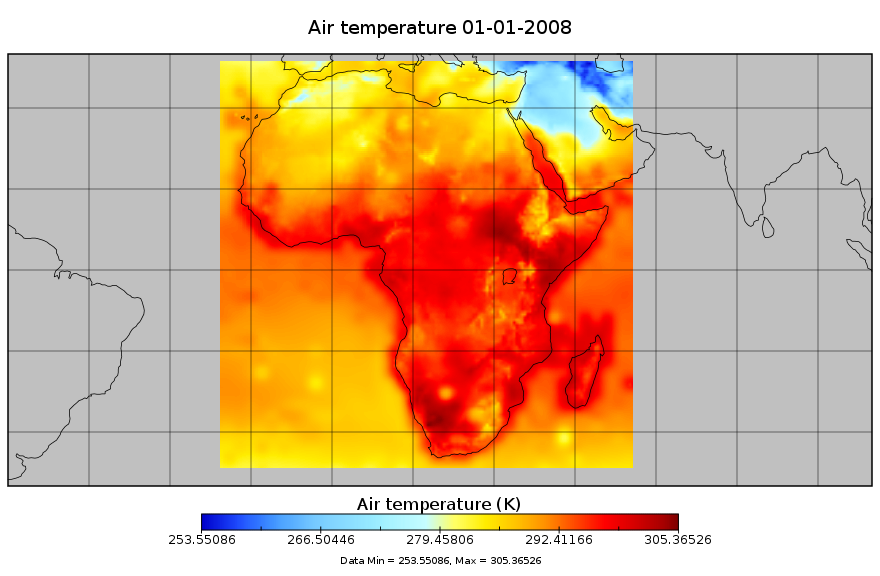air temperature
Type of resources
Available actions
Topics
Keywords
Contact for the resource
Provided by
Years
Formats
Representation types
Update frequencies
status
Scale
Resolution
-

Annual mean temperature in Djibouti, Eritrea, Ethiopia, Kenya, Somalia, Sudan and Uganda.
-
Consolidated table of air temperature. The AT_MNTHY tabular data layer is comprised of 1004351 derivative raster air temperature features derived based on 0.5_ data originally from CRES/FAO. The layer provides nominal analytical/mapping at 1:220 000 000. Acronyms and Abbreviations: CRES - Centre for Resource and Environmental Studies, The Australian National University (ANU); FAO - Food and Agriculture Organization in the United Nations.
-

Predicted mean monthly air temperature (annual). Predictions based on estimates by the Center for resource and Enviornmental Studies (CRES) which can be interpreted as estimates of standard means for the period of 1920 to 1980. The AIRTMP_MN grid data layer is comprised of 1450x1380 derivative raster air temperature features derived based on 0.05 degrees resolution data originally from CRES / FAO. The layer provides nominal analytical/mapping at 1:220 000 000. Madagascar not included. Annual Total Air Temperature, Average Monthly Air Temperature (Annual) and the Monthly Air Temperature from January to December are also available for download. Acronyms and Abbreviations: CRES - Centre for Resource and Environmental Studies, The Australian National University (ANU); FAO - Food and Agriculture Organization of the United Nations.
-

Bias Correction of ERA-interim meteorological forcing dataset for Africa, based on Piani et al. (2010) for the period 1979 - 2011. Variables description Tair: air temperature (K) Tmin: minimum air temperature (K) Tmax: maximum air temperature (K) PSurf: surface pressure (Pa) Qmean: specific humidity (kg/kg) Wind: wind speed (m/s) Precip: precipitation (mm) LWdown: Downwards long-wave radiation flux (W/m-2) SWdown: Downwards short-wave radiation flux (W/m-2). This data set has been produced in the framework of the "Climate change predictions in Sub-Saharan Africa: impacts and adaptations (ClimAfrica)" project, Work Package 1 (WP1). WP1 (Past climate variability) aimed to provide consolidated data to other WPs in ClimAfrica, and to analyze the interactions between climate variability, water availability and ecosystem productivity of Sub-Saharan Africa. Various data streams that diagnose the variability of the climate, in particular the water cycle, and the productivity of ecosystems in the past decades, have been collected, analyzed and synthesized. The data streams range from ground-based observations and satellite remote sensing to model simulations. More information on ClimAfrica project is provided in the Supplemental Information section of this metadata.
-

WATCH Forcing Data 20th Century. A meteorological forcing dataset (based on ERA-40) for land surface and hydrological models (1901-2001). Data generated in 2 tranches with slightly different methodology: 1901-1957 and 1958-2001. Five variables are at 6 hourly resolution and five variables are at 3 hourly resolution: Tair_WFD_ - 2m Air temperature (K) Tmin_WFD_ - 2m Minimum air temperature (K) Tmax_WFD_ - 2m Maximum air temperature (K) PSurf_WFD_ - 10m Surface pressure (Pa) Qair_WFD_ - 2m Specific umidity (kg/kg) Wind_WFD_ - 10m Wind speed (m/s) LWdown_WFD_ - Downwards long-wave radiation flux (W/m-2) SWdown_WFD_ - Downwards short-wave radiation flux (W/m-2) Rainf_WFD_GPCC_ - Rainfall rate GPCC bias corrected and undercatch corrected Snowf_WFD_GPCC_ - Snowfall rate GPCC bias corrected and undercatch corrected (kg/m-2/s) Rainf_WFD_CRU_ - Rainfall rate CRU bias corrected and undercatch corrected (kg/m-2/s) Snowf_WFD_CRU_ - Snowfall rate CRU bias corrected and undercatch corrected (kg/m-2/s). This data set has been produced in the framework of the "Climate change predictions in Sub-Saharan Africa: impacts and adaptations (ClimAfrica)" project, Work Package 1 (WP1). WP1 (Past climate variability) aimed to provide consolidated data to other WPs in ClimAfrica, and to analyze the interactions between climate variability, water availability and ecosystem productivity of Sub-Saharan Africa. Various data streams that diagnose the variability of the climate, in particular the water cycle, and the productivity of ecosystems in the past decades, have been collected, analyzed and synthesized. The data streams range from ground-based observations and satellite remote sensing to model simulations. More information on ClimAfrica project is provided in the Supplemental Information section of this metadata.
-

Bias-corrected and downscaled future climate meterological forcing data for Africa, for the period 1948-2099. This dataset is derived from the Global Meteorological Forcing Dataset for Land Surface Modeling, produced by the Princeton University [Department of Civil and Environmental Engineering]. The source data is a 150-yr (1948-2099) dataset of meteorological forcings for driving land surface models and other land modeling schemes. It is derived by bias correcting and downscaling WCRP CMIP3 climate model data for the 20th century and 21st century future climate projections. The dataset is bias-corrected and downscaled using the newly developed equidistant quantile matching method (Li et al., 2010) which better represents changes in the full distribution (not just the mean change). In addition to precipitation and temperature, radiation, humidity, pressure and windspeed are also downscaled. The downsclaing is based on the observational based global forcing dataset of Sheffield et al. (2006) also available from this website. The dataset is currently available at 1.0 degree, 3-hourly resolution globally for 1948-2008. Experimental versions include a 1901-2008 version, real-time updates, higher resolution versions at 0.25deg and 0.5deg and future climate projections based on bias-corrected climate model output. The data are currently available for one climate model (NCAR-PCM1) for the 20th century historical forcing (20C3M; 1948-2000) and one future climate scenario (SRES A2; 2001-2099). This work was supported by NSF Project 0629471 "Collaborative research: Understanding change in the climate and hydrology of the Arctic land region: Synthesizing the results of the ARCSS Fresh Water Initiative Projects". Variables description Tair: 2 m air temperature (K) PSurf: 2 m surface pressure (Pa) Qair: specific humidity (kg/kg) Wind: 10m wind speed (m/s) Precip: precipitation (mm) LWdown: Downwards long-wave radiation flux (W/m-2) LWnet: Net short-wave radiation flux (W/m-2) SWdown: Downwards short-wave radiation flux (average) (W/m-2) This data set has been produced for driving land surface models and other land modeling schemes, in the framework of the "Climate change predictions in Sub-Saharan Africa: impacts and adaptations (ClimAfrica)" project, Work Package 1 (WP1).
 FAO Map Catalog
FAO Map Catalog